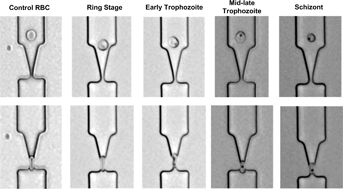Microfluidic biomechanical assay for red blood cells parasitized by Plasmodium falciparum
Abstract
Red blood cells parasitized by Plasmodium falciparum can be distinguished from uninfected cells and characterized on the basis of reduced deformability. To enable improved and simplified analysis, we developed a microfluidic device to measure red blood cell deformability using precisely controlled pressure. Individual red blood cells are deformed through multiple funnel-shaped constrictions with openings ranging from 5 down to 1 μm. Precisely controlled pressures are generated on-chip using a microfluidic circuit that attenuates an externally applied pressure by a factor of 100. The pressures required to squeeze each cell through the constriction are used as a readout to determine the intrinsic stiffness of each cell. Using this method, parasitized cells from ring through schizont stages were shown to be 1.5 to 200 times stiffer than uninfected cells. The measured deformability values of uninfected and parasitized cells showed clearly distinct distributions, demonstrating the potential of using this technique to study the pathophysiology of this disease, and the effect of potential


 Please wait while we load your content...
Please wait while we load your content...